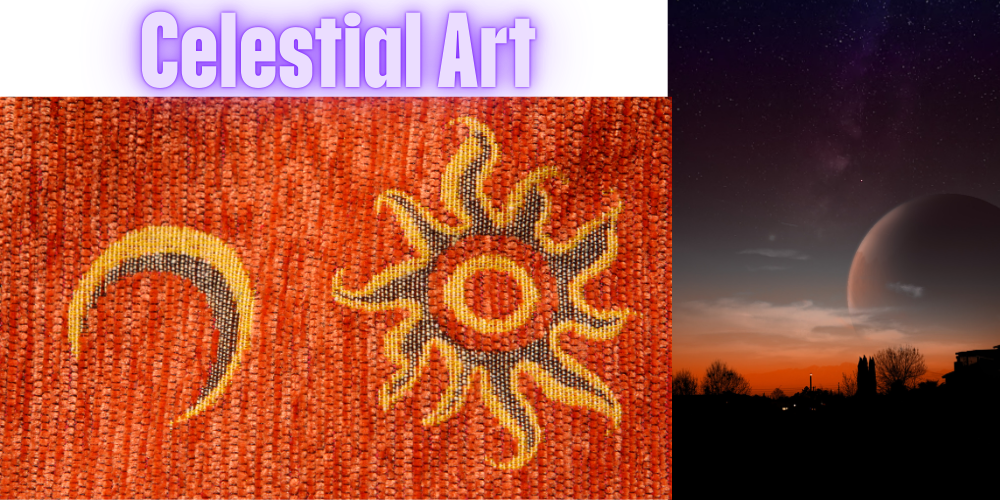The cosmos has been marvelled at by artists and stargazing lovers alike throughout history. Celestial art draws its inspiration from the beauty of the universe and tries to convey in an aesthetic way how awe-inspiring and mysterious it is. From the days of prehistoric cave paintings conceptualizing constellations to contemporary digital art showcasing far-off galaxies, this group has adapted to our comprehension of the universe.
Historical Perspective
In ancient times, the dawn of celestial art was imbued with religious goals — it had a strong symbolism. Civilizations across the ancient world have long consulted and devised predictive systems based upon the motions of celestial entities holding dominion over earthly circumstances. Cave images from India to Lascaux in France describe various constellations and astronomical circumstances, recommending a hefty portion of the earliest endeavours at composing what they saw around all through the night.
Renaissance artists such as Michelangelo and Leonardo da Vinci gradually became aware of astronomy, leading to a new era in the art world. The Age of Exploration only fueled this curiosity with even more new discoveries to satisfy a thirst for knowledge about the universe. Artists such as Étienne Léopold Trouvelot meticulously documented celestial objects in elaborate drawings and paintings, adding to the form of artsy science.
Modern Interpretations
With the advent of digital tools and photography, celestial art has taken on new forms. Astrophotography captures stunning images of celestial objects, revealing intricate details and vibrant colours often invisible to the naked eye. Digital artists utilize advanced software to create breathtaking visualizations of galaxies, nebulae, and other cosmic phenomena, pushing the boundaries of artistic expression.
Contemporary celestial art often blends scientific accuracy with artistic interpretation. Artists draw inspiration from astronomical data and images, but they also infuse their work with personal expression and emotion. This fusion of science and art creates a unique and captivating visual experience.
Themes and Inspirations
Celestial art encompasses an extensive range of themes and subjects, including:
- Constellations and Zodiacs: Commonly, constellations and zodiacs are depicted by many artists, who also elaborate them with mythological resources.
- Planets and Moons: Each planetary body has its own inimitable features, making them an inexhaustible resource of artistic inspiration from the churning storms on Jupiter to Saturn’s icy rings.
- Galaxies and Nebulae: Galaxies and nebulas, with their swirling wisps of gas dust, can be presented in celestial art.
- Astronomical Events: Eclipses, meteor Showers and comets captivate the human imagination through their intense spectacles by providing riveting but ephemeral experiences of a cosmic muse that is often reflected in art.
- Astronauts and Space Exploration: The adventure of humans to unlock mysteries in outer space has also inspired artists with visions of astronauts, spacecraft, and the future styles for interstellar travel.
The Impact of Celestial Art
Celestial art can also serve a potent educational and inspirational role by educating the public and stunning them with its beauty. At the same time, it encourages viewers to learn and explore more about space science and astronomy. This art popularises astronomy by explaining complex scientific concepts visually.
Angelic art also triggers a breathtaking, awe-inspiring circulation; it makes this scenario of flickering radiant light afresh in our imagination to put US BACK INTO PERSPECTIVE within the bigger picture. It encourages us to think about how we fit into the universe, cultivating not only humility and awe but reverence for nature.
Conclusion
The art of the heavens is a testament to our ancient fascination with those unreachable and exceptionally beautiful destinations. Artists have been using various media to capture the beauty and mystery of our universe, from ancient cave paintings all the way up to modern digital creations. Celestial art beautifully merges scientific accuracy with artistic expression and inspires, educates, and reminds us of our universe’s enormity. It is there to remind us of infinity, a reminder that we are just one small part of such a grand universe, prodding at our senses and urging them to explore and discover the awe-inspiring celestials beyond.
Disclaimer
This blog explores the fascinating realm of celestial art, where artistic expression meets the wonders of the cosmos. While many artists strive for scientific accuracy in their depictions of celestial objects and phenomena, artistic license allows for creative interpretation and imaginative visualizations. It’s important to appreciate celestial art for both its scientific inspiration and its artistic merit, recognizing that the primary goal is to evoke wonder, inspire curiosity, and foster appreciation for the beauty of the universe.
Therefore, the interpretations and representations of celestial objects in the artworks discussed might not always strictly adhere to scientific precision. This blog aims to celebrate the diverse expressions within celestial art, acknowledging the balance between scientific accuracy and artistic freedom.


